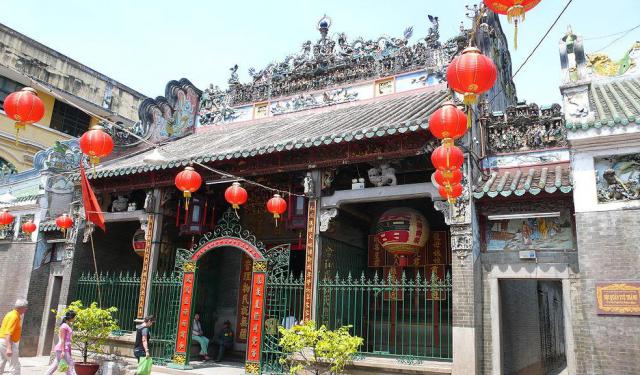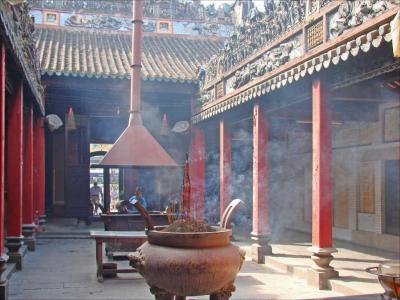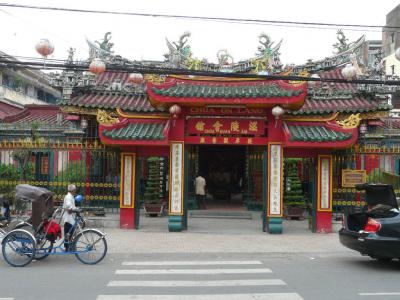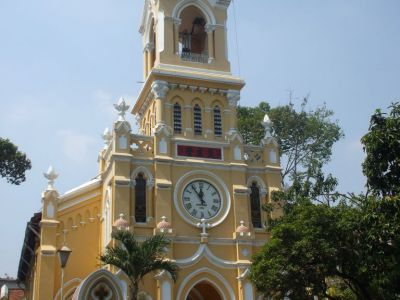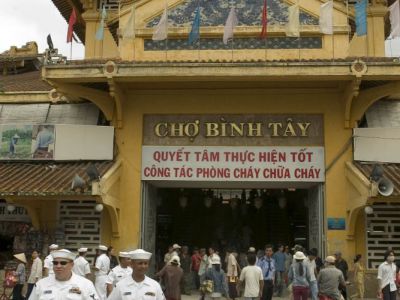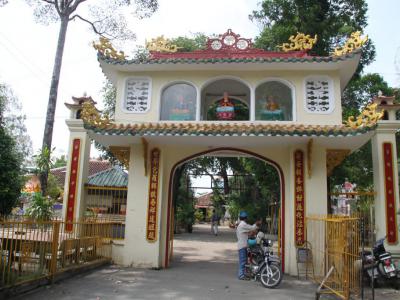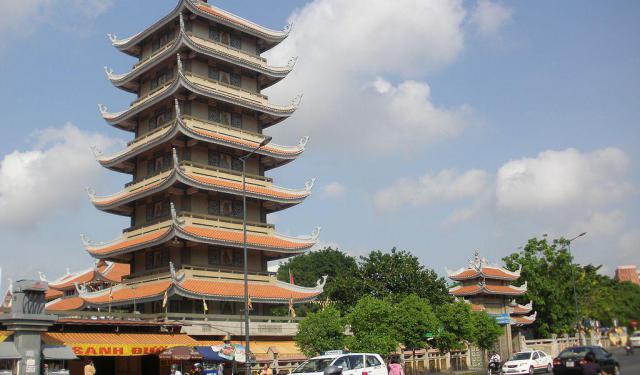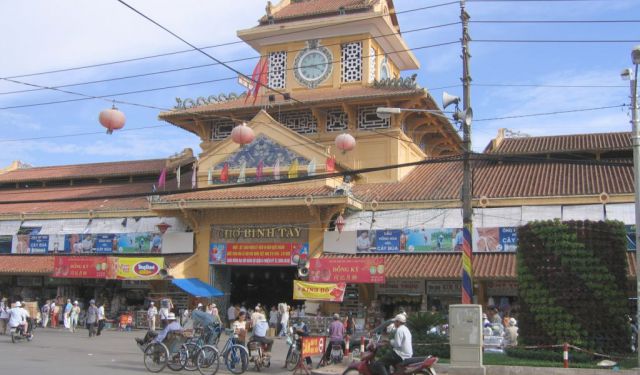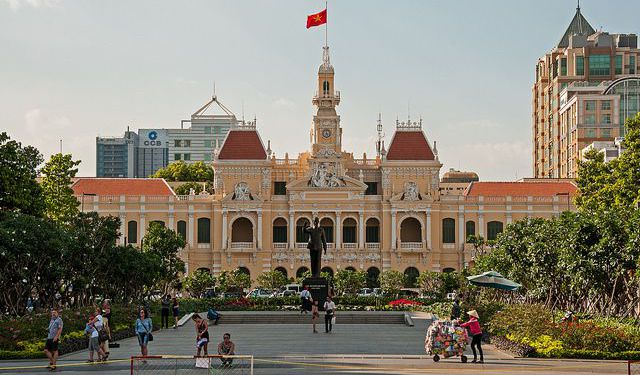Chinatown Walking Tour (Self Guided), Saigon/HoChiMinh City
The relationship between Vietnam and China traces back over 2,000 years. Over this time, Vietnamese culture, customs, administrative system, and even the language have been heavily influenced by the great northern neighbor. So much so, in fact, that although Vietnam had its own spoken language, until the late 1800s its official written language was Chinese.
Chinatown in Ho Chi Minh City, otherwise known as Cho Lon, is a vibrant and culturally rich neighborhood. Located in District 5, this bustling area vividly showcases the fusion of Chinese and Vietnamese cultures manifested in numerous Chinese temples and pagodas, plus the neighborhood's main market offers a wealth of traditional Chinese food and goods.
One of the most prominent landmarks in Chinatown is the Thien Hau Temple. This beautifully adorned temple is dedicated to the goddess of the sea, Thien Hau, and is a popular place of worship for both Chinese and Vietnamese communities. Its intricate architecture and ornate decorations make it a must-visit spot for tourists.
Another notable site in the area is the Quan Am Temple, dedicated to the goddess of mercy, Quan Am. This house of worship is known for its serene atmosphere and beautiful sculptures, providing a peaceful escape from the bustling streets of Chinatown.
Cha Tam Church, a Catholic church with a Chinese architectural influence, adds to the cultural diversity of the neighborhood. Its unique blend of Western and Eastern architectural elements makes it a captivating sight for visitors.
For shopping enthusiasts, Binh Tay Market is a bustling hub where you can find a wide variety of goods, from fresh produce to textiles and souvenirs. Exploring this market is a sensory delight, with the sights and sounds of vendors and shoppers creating a lively atmosphere.
Finally, Phung Son Pagoda is another gem of Chinatown, known for its tranquil gardens and intricate Buddhist sculptures. It's a place where you can find a moment of peace and reflection amidst the urban chaos.
Given the diversity of Chinatown in Ho Chi Minh City, missing a chance to explore it would be a shame. So, use the opportunity and take our self-guided tour of this fascinating part of the city. You're going to enjoy it!
Chinatown in Ho Chi Minh City, otherwise known as Cho Lon, is a vibrant and culturally rich neighborhood. Located in District 5, this bustling area vividly showcases the fusion of Chinese and Vietnamese cultures manifested in numerous Chinese temples and pagodas, plus the neighborhood's main market offers a wealth of traditional Chinese food and goods.
One of the most prominent landmarks in Chinatown is the Thien Hau Temple. This beautifully adorned temple is dedicated to the goddess of the sea, Thien Hau, and is a popular place of worship for both Chinese and Vietnamese communities. Its intricate architecture and ornate decorations make it a must-visit spot for tourists.
Another notable site in the area is the Quan Am Temple, dedicated to the goddess of mercy, Quan Am. This house of worship is known for its serene atmosphere and beautiful sculptures, providing a peaceful escape from the bustling streets of Chinatown.
Cha Tam Church, a Catholic church with a Chinese architectural influence, adds to the cultural diversity of the neighborhood. Its unique blend of Western and Eastern architectural elements makes it a captivating sight for visitors.
For shopping enthusiasts, Binh Tay Market is a bustling hub where you can find a wide variety of goods, from fresh produce to textiles and souvenirs. Exploring this market is a sensory delight, with the sights and sounds of vendors and shoppers creating a lively atmosphere.
Finally, Phung Son Pagoda is another gem of Chinatown, known for its tranquil gardens and intricate Buddhist sculptures. It's a place where you can find a moment of peace and reflection amidst the urban chaos.
Given the diversity of Chinatown in Ho Chi Minh City, missing a chance to explore it would be a shame. So, use the opportunity and take our self-guided tour of this fascinating part of the city. You're going to enjoy it!
How it works: Download the app "GPSmyCity: Walks in 1K+ Cities" from Apple App Store or Google Play Store to your mobile phone or tablet. The app turns your mobile device into a personal tour guide and its built-in GPS navigation functions guide you from one tour stop to next. The app works offline, so no data plan is needed when traveling abroad.
Chinatown Walking Tour Map
Guide Name: Chinatown Walking Tour
Guide Location: Vietnam » Saigon/HoChiMinh City (See other walking tours in Saigon/HoChiMinh City)
Guide Type: Self-guided Walking Tour (Sightseeing)
# of Attractions: 5
Tour Duration: 1 Hour(s)
Travel Distance: 3.0 Km or 1.9 Miles
Author: vickyc
Sight(s) Featured in This Guide:
Guide Location: Vietnam » Saigon/HoChiMinh City (See other walking tours in Saigon/HoChiMinh City)
Guide Type: Self-guided Walking Tour (Sightseeing)
# of Attractions: 5
Tour Duration: 1 Hour(s)
Travel Distance: 3.0 Km or 1.9 Miles
Author: vickyc
Sight(s) Featured in This Guide:
- Thien Hau Temple
- Quan Am Temple
- Cha Tam Church
- Binh Tay Market
- Phung Son Pagoda
1) Thien Hau Temple (must see)
Located in the Cho Lon or Chinatown area of Ho Chi Minh City, this temple is dedicated to Thien Hau, the Goddess of the Sea. Members of the Chinese community and the Vietnamese come here to pray for happiness and prosperity.
Thien Hau or Mazu, the Goddess of the Sea is worshipped by the seafaring communities of Southern China and by Chinese communities around the world who depend on the sea for their livelihood. She is not a Taoist or a Buddhist Deity but has been assimilated by both religions. The Thien Hau temple was first built in the year 940. It has been destroyed and rebuilt many times and the present building dates back to 1900. It is believed that she left two giant turtles to look after the people and ascended to the heavens.
The interior of the Thien Hau Temple is a large covered courtyard and the statue of chief deity and two other Goddesses are located at one end. Urns to place incense sticks are placed in the open spaces around the courtyard. The ceiling is covered with intricate porcelain reliefs depicting a 19th-century Chinese city and tales from Chinese history and legends. A festival is held in honor of the birthday of Thien Hau on the 23rd day of the 3rd Lunar Month. Two effigies of demons are burned and the lion dance is performed as part of the festivities.
Tip:
You need time to admire the many carvings, and a guide will add value, unless you can read Cantonese!
There's a souvenir shop inside that also sells incense sticks or the coiled incense 'cones' you can light and have hung up for you.
Thien Hau or Mazu, the Goddess of the Sea is worshipped by the seafaring communities of Southern China and by Chinese communities around the world who depend on the sea for their livelihood. She is not a Taoist or a Buddhist Deity but has been assimilated by both religions. The Thien Hau temple was first built in the year 940. It has been destroyed and rebuilt many times and the present building dates back to 1900. It is believed that she left two giant turtles to look after the people and ascended to the heavens.
The interior of the Thien Hau Temple is a large covered courtyard and the statue of chief deity and two other Goddesses are located at one end. Urns to place incense sticks are placed in the open spaces around the courtyard. The ceiling is covered with intricate porcelain reliefs depicting a 19th-century Chinese city and tales from Chinese history and legends. A festival is held in honor of the birthday of Thien Hau on the 23rd day of the 3rd Lunar Month. Two effigies of demons are burned and the lion dance is performed as part of the festivities.
Tip:
You need time to admire the many carvings, and a guide will add value, unless you can read Cantonese!
There's a souvenir shop inside that also sells incense sticks or the coiled incense 'cones' you can light and have hung up for you.
2) Quan Am Temple
The Quan Am Temple is located in the predominantly Chinese, Cho Lon area of Ho Chi Minh City. It is dedicated to Quan Am the Chinese Goddess of mercy.
Chinese traders and Vietnamese merchants raised funds and constructed the Quan Am Temple in 1816. It was expanded by funds raised by a congregation from the Chinese Fujian province. From the date of construction, it has remained one of the most frequented temples by Chinese and Vietnamese worshippers and contains both Taoist and Buddhist objects of worship.
Visitors and worshippers enter the pagoda through a red traditional gate. There is a small courtyard between the gate and the temple complex. There are relief panels at both ends depicting Buddhist motifs. The central altar is dedicated to Ngoc Huang or the Jade Emperor. Other altars are of the Amitabha Buddha and three Bodhisattvas. Inside the Pagoda, the main altar is that of the Goddess of the sea, Thien Hau. Beyond the altar the main deity is located in a partially covered courtyard. The Chinese Quan Am statue is flanked by two smaller figures. There are many other altars dedicated to figures from Buddhist and Taoist legends and wooden figures of Arhats or Buddhist holy men. On the other side of the street is a garden that forms part of the temple complex with an artificial pond surrounded by relief panels depicting Taoist motifs.
Chinese traders and Vietnamese merchants raised funds and constructed the Quan Am Temple in 1816. It was expanded by funds raised by a congregation from the Chinese Fujian province. From the date of construction, it has remained one of the most frequented temples by Chinese and Vietnamese worshippers and contains both Taoist and Buddhist objects of worship.
Visitors and worshippers enter the pagoda through a red traditional gate. There is a small courtyard between the gate and the temple complex. There are relief panels at both ends depicting Buddhist motifs. The central altar is dedicated to Ngoc Huang or the Jade Emperor. Other altars are of the Amitabha Buddha and three Bodhisattvas. Inside the Pagoda, the main altar is that of the Goddess of the sea, Thien Hau. Beyond the altar the main deity is located in a partially covered courtyard. The Chinese Quan Am statue is flanked by two smaller figures. There are many other altars dedicated to figures from Buddhist and Taoist legends and wooden figures of Arhats or Buddhist holy men. On the other side of the street is a garden that forms part of the temple complex with an artificial pond surrounded by relief panels depicting Taoist motifs.
3) Cha Tam Church
The Cha Tam Church is a Roman Catholic parish Church in Ho Chi Minh City. It has a distinctive colonial façade and is painted in pastel yellow and white.
The church was founded due to the efforts of a Chinese Catholic Priest, Francis Xavier Tam Assou in 1900. On December the 3rd, 1900, which coincided with the feast of Saint Francis Xavier, Bishop Bossard laid the foundation stone. It was consecrated in 1902 and Tam Assou was its first priest. It was here that the Roman Catholic president of South Vietnam Ngo Dinh Diem and his brother Ngo Dinh Nu hid during an attempted coup. When their attempts to contact loyal military officers failed, they were discovered and shot dead after being taken into custody by the leaders of the coup.
Cha Tam has been an active church from its foundation to date. The tower holds the statue of Tam Assou. He was a Chinese born vicar apostolate or representative of the Pope. He was sent to look after the affairs of the Chinese Catholics in the Cho Lon neighborhood of Saigon. A daily mass is held and the congregation consists of 3000 Vietnamese and 2000 ethnic Chinese parishioners. It is the only Catholic Church in Saigon with horizontal lacquered boards similar to a Chinese temple in the interiors.
Why You Should Visit:
Not the biggest church in town, but this one is a great place for a breather and it does boast a fine garden off to the side.
The church was founded due to the efforts of a Chinese Catholic Priest, Francis Xavier Tam Assou in 1900. On December the 3rd, 1900, which coincided with the feast of Saint Francis Xavier, Bishop Bossard laid the foundation stone. It was consecrated in 1902 and Tam Assou was its first priest. It was here that the Roman Catholic president of South Vietnam Ngo Dinh Diem and his brother Ngo Dinh Nu hid during an attempted coup. When their attempts to contact loyal military officers failed, they were discovered and shot dead after being taken into custody by the leaders of the coup.
Cha Tam has been an active church from its foundation to date. The tower holds the statue of Tam Assou. He was a Chinese born vicar apostolate or representative of the Pope. He was sent to look after the affairs of the Chinese Catholics in the Cho Lon neighborhood of Saigon. A daily mass is held and the congregation consists of 3000 Vietnamese and 2000 ethnic Chinese parishioners. It is the only Catholic Church in Saigon with horizontal lacquered boards similar to a Chinese temple in the interiors.
Why You Should Visit:
Not the biggest church in town, but this one is a great place for a breather and it does boast a fine garden off to the side.
4) Binh Tay Market
The Binh Tay Market located in the Cho Lon area of Ho Ch Minh City draws tourists looking for bargains. It is also famous because of its unique Chinese architecture. It is a large wholesale market with a green central courtyard.
The Binh Tay market was funded by a wealthy Chinese trader, Quach Dam who came from Chiu Chow in China and made his fortune in Saigon. His trade name was Thong Heip and was nicknamed handicapped Thong by the local Chinese. He came to the city as a poor man who started recycling garbage. He soon diversified and became one of the most successful businessmen in the city.
At the center of Binh Tay Market is a courtyard. A statue of its founder once stood at the center surrounded by four bronze lions. The original statue was removed and a glass altar was placed at the location between 1976 and 1980. One can find the original statue in the Museum of Fine Arts. Shops selling international branded cosmetics are located on the second floor of the market. An array of bowls pots and pans for homes and restaurants are also on sale. It is known to the locals as a wholesale market where retailers come to buy products in bulk. Tourists can find interesting souvenirs here at bargain prices.
The Binh Tay market was funded by a wealthy Chinese trader, Quach Dam who came from Chiu Chow in China and made his fortune in Saigon. His trade name was Thong Heip and was nicknamed handicapped Thong by the local Chinese. He came to the city as a poor man who started recycling garbage. He soon diversified and became one of the most successful businessmen in the city.
At the center of Binh Tay Market is a courtyard. A statue of its founder once stood at the center surrounded by four bronze lions. The original statue was removed and a glass altar was placed at the location between 1976 and 1980. One can find the original statue in the Museum of Fine Arts. Shops selling international branded cosmetics are located on the second floor of the market. An array of bowls pots and pans for homes and restaurants are also on sale. It is known to the locals as a wholesale market where retailers come to buy products in bulk. Tourists can find interesting souvenirs here at bargain prices.
5) Phung Son Pagoda
The Phung Son Pagoda also called the Go Pagoda, is located in District 11, Ho Chi Minh City. It has been declared a national Historical and Cultural Vestige by the Government.
The Pagoda was built by a Bonze or monk named Lieu Thong between 1802 and 1820. Archeological excavations have revealed that there were structures from the Funan civilization at the site before the construction of the temple. According to legend, it was at one time decided to move the location of the temple. All artifacts were loaded on an elephant for transportation to the new site. On the way, the elephant tripped and many relics fell into a nearby pond. Local people saw this as a sign that the temple should stay in its original location. It has been renovated twice, once between 1904 and 1915 by the Bonze, Tue Minh and later in 1960.
The Phung Son Pagoda has many notable artifacts. There are over 40 gilded wooden statues. Other valuable objects are the Di Da Tam Ton statue, the gilded stone statue of the Buddha called the Ngu Hien Thuong Ky Thu and a statue of Tieu Dien made of ceramic. Archeological excavations around the temple have unearthed objects made of baked earth and ceramics belonging to the Funan Oc Eo civilization.
Tip:
The main entrances are locked most of the time, but the side entrance is open during prayer times (4-5pm, 6-7 pm).
The Pagoda was built by a Bonze or monk named Lieu Thong between 1802 and 1820. Archeological excavations have revealed that there were structures from the Funan civilization at the site before the construction of the temple. According to legend, it was at one time decided to move the location of the temple. All artifacts were loaded on an elephant for transportation to the new site. On the way, the elephant tripped and many relics fell into a nearby pond. Local people saw this as a sign that the temple should stay in its original location. It has been renovated twice, once between 1904 and 1915 by the Bonze, Tue Minh and later in 1960.
The Phung Son Pagoda has many notable artifacts. There are over 40 gilded wooden statues. Other valuable objects are the Di Da Tam Ton statue, the gilded stone statue of the Buddha called the Ngu Hien Thuong Ky Thu and a statue of Tieu Dien made of ceramic. Archeological excavations around the temple have unearthed objects made of baked earth and ceramics belonging to the Funan Oc Eo civilization.
Tip:
The main entrances are locked most of the time, but the side entrance is open during prayer times (4-5pm, 6-7 pm).
Walking Tours in Saigon/HoChiMinh City, Vietnam
Create Your Own Walk in Saigon/HoChiMinh City
Creating your own self-guided walk in Saigon/HoChiMinh City is easy and fun. Choose the city attractions that you want to see and a walk route map will be created just for you. You can even set your hotel as the start point of the walk.
Historical Religious Sites
For centuries, Vietnamese people have practiced Confucianism and Buddhism brought over from neighboring China. Added to these Eastern teachings, in the 16th century, was Christianity – introduced to Vietnam by Western missionaries. The result of this variety of faiths has become a mixture of gorgeous Confucian and Buddhist temples and Catholic churches in Ho Chi Minh City. Some of these... view more
Tour Duration: 2 Hour(s)
Travel Distance: 5.9 Km or 3.7 Miles
Tour Duration: 2 Hour(s)
Travel Distance: 5.9 Km or 3.7 Miles
Saigon Shopping Tour
Among other accolades, Ho Chi Minh City is known as a great shopping destination. Attesting to its reputation are a plethora of street markets scattered throughout the city, selling all sorts of fresh local produce, including coffee beans, and other delights, not to mention street food and souvenirs – all at extremely competitive prices. There are also designated markets specialized in niche... view more
Tour Duration: 1 Hour(s)
Travel Distance: 3.0 Km or 1.9 Miles
Tour Duration: 1 Hour(s)
Travel Distance: 3.0 Km or 1.9 Miles
Saigon/HoChiMinh City Introduction Walking Tour
While many people still fondly say “Saigon,” the city officially became Ho Chi Minh City or HCMC in 1976, to honor the revolutionary leader who led North Vietnam. But call it what you will – Saigon still lives in the names, food stalls, and in locals’ hearts, especially in District 1, the area most of us think of when we say “Saigon.”
Long before colonial buildings and skyscrapers,... view more
Tour Duration: 3 Hour(s)
Travel Distance: 4.9 Km or 3 Miles
Long before colonial buildings and skyscrapers,... view more
Tour Duration: 3 Hour(s)
Travel Distance: 4.9 Km or 3 Miles
The Most Popular Cities
/ view all
